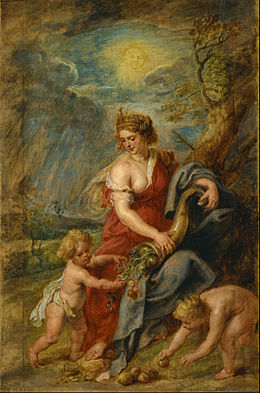
Back قرن الوفرة Arabic Рог дастатку Byelorussian Рог на изобилието Bulgarian Cornucopia Breton Cornucòpia Catalan Roh hojnosti Czech Overflødighedshorn Danish Füllhorn German Αμαλθείας κέρας Greek Korno de abundeco Esperanto

In classical antiquity, the cornucopia (/ˌkɔːrn(j)əˈkoʊpiə, -n(j)uː-/; from Latin cornu 'horn' and copia 'abundance'), also called the horn of plenty, was a symbol of abundance and nourishment, commonly a large horn-shaped container overflowing with produce, flowers, or nuts.
Baskets or panniers of this form were traditionally used in western Asia and Europe to hold and carry newly harvested food products. The horn-shaped basket would be worn on the back or slung around the torso, leaving the harvester's hands free for picking.